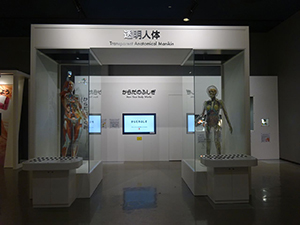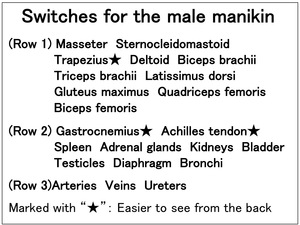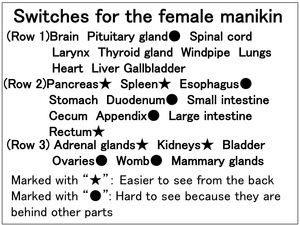Nagoya City Science Museum
TOP > Exhibition Guide > Keyword Search > Starting with "T" > transparent > Transparent Anatomical Manikin(Male)(Female)
Transparent Anatomical Manikin(Male)(Female)



Purpose of Exhibition
Pressing a switch on the table in front of a transparent anatomical manikin (male or female) illuminates the corresponding internal organ to identify its location and shape.
The male manikin on the left mainly shows muscles (the right half of the body shows muscles close to the skin, while the left half shows muscles deep in the body and the skeletal frame), the heart, and the blood vessels. Color coding of the tube lamps is used to differentiate the substances that flow through them (oxygen-rich blood in red, oxygen-poor blood in green, air in greenish yellow, and urine in yellow).
The female manikin on the right shows the skeletal frame, internal organs, and major parts of the vascular, nervous and lymphatic systems, which extend throughout the body (the thin lines are colored as follows: arteries in red, veins in blue, the nervous system in yellow, and the lymphatic system in green).
Some of the switches are marked with a symbol. Those with “★” correspond to body parts that are easier to see from the back side than the front, while those with “●” correspond to body parts that are hard to see because they are behind other parts.
The display cases have sheet mirrors (on the case walls facing the right half and top of the male manikin, and on the glass behind the female manikin). These mirrors make it easier for you to observe the sides of the manikin other than its front when you press a switch.
Note: These manikins were originally installed in the Life Science Building when it was opened in the Nagoya City Science Museum in 1989. These reused male and female manikins bear the names of their (original) donators.
[Differences from the Original Exhibit]
The manikin-rotating and light-flashing functions, and an audio guide are no longer available.
Additional Knowledge
[You May Be Mistaken Where Internal Organs Are]
We think we know where organs are located in the body, but we may be mistaken about their locations.
Press each switch and see if the illuminated organ is where you think it is. One may be higher in the body than you think. One that you think is close to the navel may be much closer to the lower back.
[We Are Unique Inside Too]
Just as we differ in appearance, such as in our face and figure, we all are also unique inside the body.
For example, as you can easily tell from your daily experience, adult men have bigger and stronger muscles. Generally, men also have bigger and thicker bones than women. Differences between men and women are quite distinctive, of course, in each organ and bone. A little thought will tell you that among men, there are also differences between individuals.
You rarely come across many types of manikins, so you may think that all people have similar bodies, but a manikin shows only an example. It is not that all people have bodies exactly identical to the manikin. Every human body alive on earth is unique. Please remember that you have such a well-designed structure right up close to you and that it belongs only to you.
[Reuse of Old Manikins]
These anatomical manikins were originally donated by cooperators and installed in the Life Science Building when it was opened in 1989. In those days, pressing a switch flashed a light on the corresponding organ for a while, and pressing an audio guide switch played an audio guide while one part of the manikin was illuminated after another in a prescribed order. The manikins also had the function of turning 90 degrees to show their sides and backs as well. In the spring of 2016, when the “Wonders of Human Body” floor was remodeled, these manikins were removed to be stored. Today, they are exhibited again in new display cases with new switches. The only mechanical function that has remained unchanged is that of illuminating the corresponding organ when a switch is pressed.
Cooperation by:
The Tokai Bank, Ltd.
SUZUKEN Co., Ltd.
Article by Tomoko Horiuchi, curator
